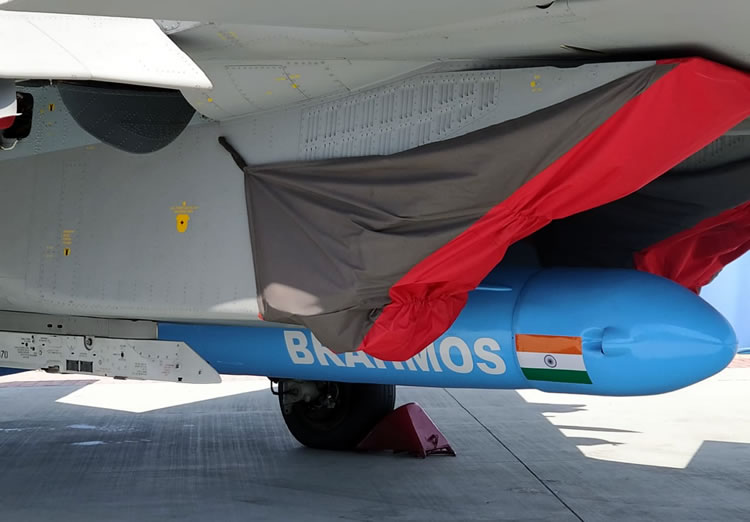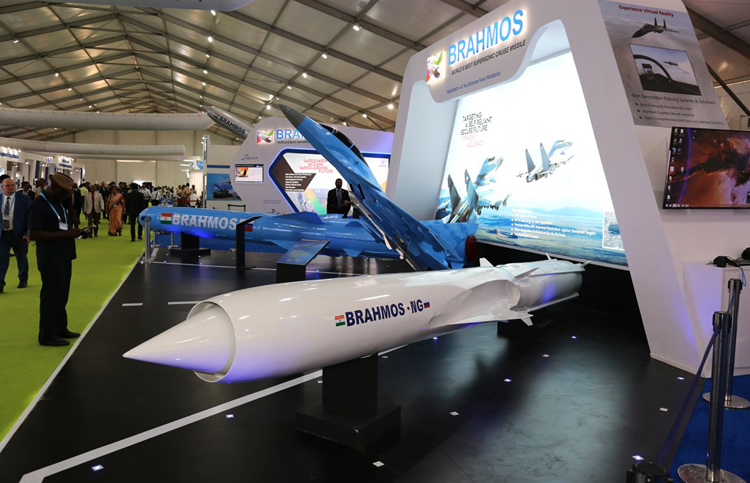INDIAN ARMED FORCES CHIEFS ON
OUR RELENTLESS AND FOCUSED PUBLISHING EFFORTS

SP Guide Publications puts forth a well compiled articulation of issues, pursuits and accomplishments of the Indian Army, over the years

I am confident that SP Guide Publications would continue to inform, inspire and influence.

My compliments to SP Guide Publications for informative and credible reportage on contemporary aerospace issues over the past six decades.
Extended Range BrahMos for IAF
The range of the BrahMos missile has been increased already and with the advantage of being airborne at high altitudes, the missile can travel a longer distance and can hit targets at 800 kms and beyond
 |
The Author is Former Director General of Information Systems and A Special Forces Veteran, Indian Army |

Maximising lethality, range and accuracy have been the focus in development of weapons and weapon systems over the past years. In this backdrop, BrahMos Aerospace and Indian Air Force (IAF) are developing a new air-launched extended-range version of BrahMos missile for the Su-30 MKI fighter aircraft. This version of the BrahMos would reportedly have a range of more than 800 km. The Su-30 MKI having a combat radius of 3,000 km, the extended-range missile will thus enable the Su-30 MKI fighter jets of the IAF to hit targets beyond 3,800 km.
Incidentally, the Defence Research and Development Organisation (DRDO) have recently intimated that under the DRDO's Technology Development Fund, the project for the Development of Air-to-Air Refueling Pod (ARP Pod) for tanker aircrafts has commenced. The purpose of project is to design and develop new generation air-to-air refueling pods for use on aircraft of the IAF.
With China getting more aggressive under third-term President Xi Jinping, more ASEAN nations would like to procure the world-class BrahMos cruise missile
Till now, the BrahMos missiles used by the IAF have the capability of hitting targets at around 300 km after being released from a Su-30 MKI combat aircraft. Media has now quoted an unnamed government source saying, "The range of the BrahMos missile has been increased already and with the advantage of being airborne at high altitudes, the missile can travel a longer distance and can hit targets at 800 kms and beyond."
Above would be bad news for our adversaries, particularly Pakistan, who has been periodically raking up the incident of accidental firing of a BrahMos cruise missile that landed in Pakistani territory. The missile misfired due to a technical malfunction from an Indian Air Force unit during a Command Air Staff Inspection (CASI) of the unit. India had sent an official intimation to the Pakistani authorities deeply regretting the incident and also issued a statement in this regard. No lives were lost in the incident but Pakistan is using it to question the safety of India's missile arsenal at the international level. This perhaps is also to divert attention from the possibility of Pakistan's nuclear weapons falling into terrorists hands, which has been under suspicion since past several years despite Pakistani statements to the contrary.

The IAF has equipped around 40 of its Su-30 combat aircraft with the BrahMos cruise missiles which can cause heavy destruction in enemy territory. BrahMos is a tactical missile and India has enhanced the range of the tactical missile recently which can go beyond 500 km with just an upgrade in its software.
India has already signed a $375 million deal to export the BrahMos supersonic cruise missiles to the Philippines. News reports over the past few years have indicated that Vietnam is also interested in buying the BrahMos missile system from India. There has been speculation that the deal has possibly not gone through because Russia is wary of China not liking Vietnam acquiring the BrahMos. But China has been exporting lethal weapon systems to Myanmar, Bangladesh and Pakistan to whom China also gave nuclear technology. Now with China getting more aggressive under third-term President 'Xitler' Jinping, more ASEAN nations would like to procure the world-class BrahMos cruise missile.
After the successful test-firing of the Hypersonic Technology Demonstrator Vehicle (HSTDV) on September 7, 2020, India is developing the hypersonic version of the BrahMos cruise missile
After the successful test-firing of the Hypersonic Technology Demonstrator Vehicle (HSTDV) on September 7, 2020, India is developing the hypersonic version of the BrahMos cruise missile. There was speculation in media that the first hypersonic missile will be developed in the next five years, which is expected to have speeds exceeding Mach 6, possibly reaching Mach 8, and a range of 600 km that could be extended to 1,000 km.
Speaking to Russia's state-owned TASS news agency on August 1, 2022, Atul Rane, CEO of BrahMos Aerospace, had stated that the hypersonic version of India's BrahMos cruise missile (BrahMos-II) is likely to have the same performance characteristics as Russia's Tsirkon (Zircon) missile and is supposed to succeed the Indian Navy's BrahMos supersonic anti-ship cruise missile. According to Rane, it would take up to five or six years before the first flight trial of BrahMos-II could begin. Rane also said that both the Indian and Russian sides are working on the design of the hypersonic BrahMos version.
BrahMos Aerospace is also developing the next generation BrahMos NG cruise missile, having a land-based variant for the Indian Army, a variant for the Indian Air Force and a ship and submarine-compatible variant for the Navy
Russia's 3M22 Zircon (also spelled as 3M22 Tsirkon in Russian) is a scramjet powered maneuvering anti-ship cruise missile, which has already been successfully tested by Russia. It has a flight range of 1500 km and President Vladimir Putin had earlier said that the Zircon missile would have a speed of Mach 9 (over 11,000 km/h). According to Russian officials, it is impossible to intercept the Zircon missile with "existing" anti-missile systems due to the 'plasma shield' it creates while flying, making it practically invisible to active radar systems.
As mentioned in these columns earlier, BrahMos Aerospace is also developing the next generation BrahMos NG cruise missile, having a land-based variant for the Indian Army, a variant for the Indian Air Force and a ship and submarine-compatible variant for the Navy.According to media, the Ministry of Defence (MoD) has also signed a deal with BrahMos Aerospace worth 1,700 crore for the acquisition of 35 additional dual-role capable surface-to-surface BrahMos missiles for the Indian Navy, to equip the two Project 15B Ships or the Visakhapatnam-class guided-missile stealth destroyers.





